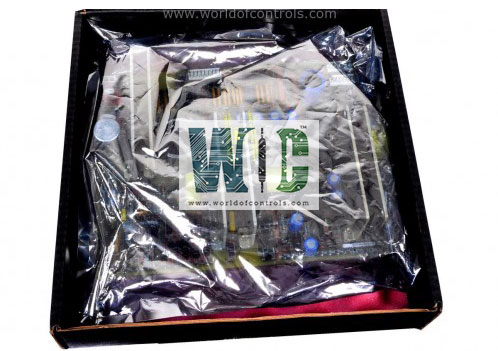
World Of Controls understands the criticality of your requirement and works towards reducing the lead time as much as possible.
IS230SSCA2ASSCA2AG11 - Simplex Serial Communication I/O Terminal Board is available in stock which ships the same day.
IS230SSCA2ASSCA2AG11 - Simplex Serial Communication I/O Terminal Board comes in UNUSED as well as REBUILT condition.
To avail our best deals for IS230SSCA2ASSCA2AG11 - Simplex Serial Communication I/O Terminal Board, contact us and we will get back to you within 24 hours.
SPECIFICATIONS:
Part Number: IS230SSCA2ASSCA2AG11
Manufacturer: General Electric
Series: Mark VIe
Product Type: Simplex Serial Communication I/O Terminal Board
Number of channels: 6
Input Span: 1-5 V dc
Outputs: 24 V outputs
Technology: Surface Mount
Maximum Lead Resistance: 15Ω
Output load: 500 Ω
Analog output current: 0-20 mA
Operating temperature: -30 to 65 °C
Size: 15.9 cm high x 10.2 cm
Repair: 3-7 Day
Availability: In Stock
Country of Origin: United States
Manual: GEH-6721L
FUNCTIONAL DESCRIPTION:
IS230SSCA2ASSCA2AG11 is a Simplex Serial Communication I/O Terminal Board manufactured and designed by General Electric as part of the Mark VIe Series used in GE Distributed Control Systems. The Simplex Serial Communication Input/Output (SSCA) terminal board is a compact serial communication terminal board that provides up to six communication channels. Each channel may be configured for RS-232C, RS-485, or RS-422 signaling. The PSCA I/O pack works with the SSCA. The I/O pack plugs into the DC-37 pin connector and communicates with the controller over Ethernet.
INSTALLATION:
The SSCA board is mounted on a DIN rail using a sheet metal carrier and plastic insulator mount. This assembly will also bolt directly into a cabinet. There are two types of Euro-Block terminal blocks available:
Wiring with a shielded twisted pair gauge of #18 is what SSCA often utilizes. An external mounting bracket provided by the customer or by GE holds the I/O cable shield termination. Using E1 and E2 as mounting holes, the chassis ground connection is installed. There must be a shield ground connection made to one of the SCOM terminals (37–48).
OPERATION:
For each of the six serial communication channels, the SSCA terminal board has six connection points. Four signal lines A through D, a signal return, and a shield common are included in the points (SCOM). The following table displays the signal assignments.
The order of the signals for each of the six serial communication channels is the same. The signals are SCOM, A, B, C, D, and Ret when looking into the box terminals from left to right. A serial channel's six signal groups are assigned to terminals that are close to one another. The channels are five, four, and one when looking at the bottom set of terminals from left to right. Channels 6, 3, and 2 are located on the top row of terminals when viewed from left to right. On the right side of the terminals, a group of board SCOM connections are located. On SSCA, a straightforward diagram is provided to help with signal location identification.
There must be a termination resistor at either end of a transmission line when utilizing RS-422 or RS-485. Each pair of signal lines has a configurable termination resistor provided by SSCA. Signal termination resistors between signals A, B, and C can be applied or removed using jumpers JP1A and JP1B. For every serial communication channel, the same function is repeated. The termination resistor is disconnected in the default jumper position. The relationship between the termination jumpers and the serial communication channel signals is marked on the SSCA.
CONFIGURATION:
The terminal board can be configured using jumpers. Refer to the operating section for the position of these jumpers. The available jumpers are as follows:
WOC has the largest stock of GE Distributed Control System Replacement Parts. We can also repair your faulty boards. WORLD OF CONTROLS can also supply unused and rebuilt backed-up with a warranty. Our team of experts is available round the clock to support your OEM needs. Our team of experts at WOC is happy to assist you with any of your automation requirements. For pricing and availability on any parts and repairs, kindly get in touch with our team by phone or email.
What is a Simplex Serial Communication I/O Terminal Board?
A Simplex Serial Communication I/O Terminal Board is a hardware device used to facilitate serial communication between different electronic devices. It typically provides interfaces for connecting devices via serial ports, allowing them to exchange data.
What are the common applications of a Simplex Serial Communication I/O Terminal Board?
These boards are commonly used in various industries for tasks such as data logging, industrial automation, monitoring and control systems, robotics, and communication between embedded systems.
How does a Simplex Serial Communication I/O Terminal Board work?
The board typically interfaces with a computer or microcontroller via a serial port (e.g., RS-232, RS-485, USB). It then communicates with other devices using protocols like UART, SPI, or I2C, depending on the specific requirements of the application.